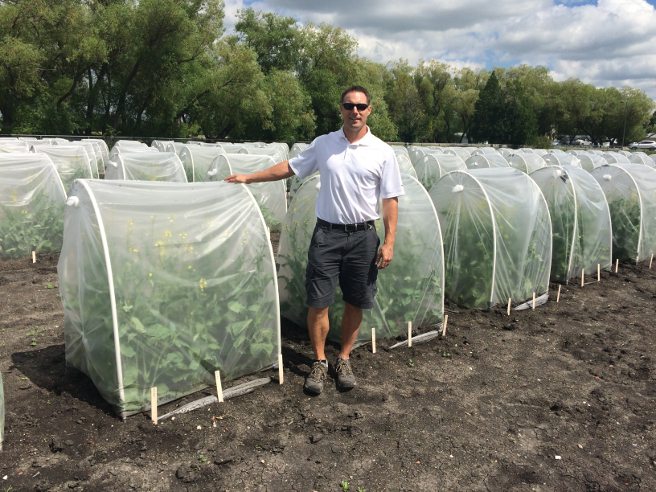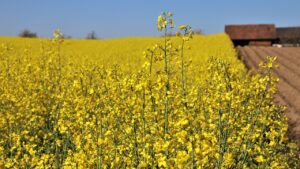What are the latest crowning achievements in research and breeding?
_x000D_
Western Canada is all about canola: according to Statistics Canada, more than 20 million acres were harvested in 2015 alone, and that figure is on a general upward trend._x000D_
_x000D_
Canola annually contributes more than $19 billion to the Canadian economy and generates over one quarter of all farm cash receipts, according to the Canola Council of Canada._x000D_
_x000D_
What’s behind the success of this humble yellow-flowered brassica? It can be contributed to many years of research and breeding efforts by some of Canada’s best and brightest. Here’s the latest from Western Canada’s research and development pipeline._x000D_
Combating Clubroot
_x000D_
“It’s important to have public-private partnerships — otherwise new research may stay on the shelf,” says Habibur Rahman, a canola breeder and professor in the department of Agricultural, Life and Environmental Sciences at the University of Alberta._x000D_
_x000D_
Rahman’s lab has partnered with Agrium subsidiary Crop Production Services (CPS) to bring clubroot resistant cultivars to market._x000D_
_x000D_
“Breeding to broaden the genetic diversity of canola is going on continually,” says Rahman. “We are making progress.”_x000D_
_x000D_
This year, CPS released PV 580 GC, Canada’s first multi-genic clubroot resistant variety, which is also resistant to the virulent clubroot pathotype 5X._x000D_
_x000D_
According to Andy Andrahennadi, a senior hybrid breeder with CPS, the company received recommendations for 10 canola hybrids during the Western Canada Canola/Rapeseed Recommending Committee meeting early this February._x000D_
_x000D_
“Four of these varieties received full recommendation. One of these hybrids is resistant to multiple pathotypes of clubroot in Western Canada, including pathotype 5X,” says Andrahennadi. “Also, it has a strong agronomic package with superior blackleg resistance.”_x000D_
_x000D_
CPS also received interim recommendation for registration for an additional six varieties, says Andrahennadi. One of them, developed through collaboration with Rahman’s breeding program and Agriculture and Agri-Food Canada (AAFC), is resistant to all major clubroot pathotypes in Western Canada._x000D_
_x000D_
All of the new hybrids will be field tested in 2017 in strip trials prior to commercialization._x000D_
Promoting Plant Growth
_x000D_
At Mark Belmonte’s lab in the University of Manitoba’s Department of Biological Sciences, a crop of students is helping to “crack the code” of canola genetics in order to understand how canola responds to biostimulants._x000D_
_x000D_
Belmonte is partnering with ATP Nutrition to better understand the mode of action of some of the company’s new biostimulant products. The project is one of eight ongoing projects in Belmonte’s lab, all of which revolve around enhancing crop performance._x000D_
_x000D_
“Biostimulants are naturally occurring products that help to promote plant growth and development,” says Belmonte. “They can work by activating the physiological responses within the plant, such as water or nutrient uptake, changes in hormone metabolism, or activation of genes and gene expression signatures.”_x000D_
_x000D_
Using RNA next-generation sequencing technology, Belmonte’s team analyzes gene expression patterns in canola cultivars, attempting to profile every gene that’s turned “on” or “off” in response to a biostimulant product, either by itself or under adverse environmental conditions._x000D_
_x000D_
Belmonte’s team—bioinformaticians and biologists—sort through the resulting billions of data points by building data analysis pipelines that turn all the information “into something that anyone can understand.” The system is so user-friendly that Winnipeg high school students sometimes help out in the lab._x000D_
_x000D_
“When you can understand the mode of action, it adds a lot of value for the consumer. It’s going above and beyond what’s expected by the company to show how the product will work,” says Belmonte._x000D_
Adding Value to Canola Meal
_x000D_
Rob Duncan’s research and breeding program at the University of Manitoba is focused on high erucic acid rapeseed (HEAR) development, and the program is a major contributor to the HEAR industry in Western Canada._x000D_
_x000D_
This lab is also student-focused; students work as scientists and breeders developing research and traits applicable to the canola industry in Canada._x000D_
_x000D_
One key project underway at Duncan’s lab looks at ways to add value to canola meal and its protein utilization, with the goal of turning canola meal into a co-product and not just a byproduct of the crushing process, according to Duncan._x000D_
_x000D_
“Because oil is the main product of our nearly 20 million acres of canola, most research has gone into the oil and fatty acid content,” Duncan explains. “I think there are opportunities for the protein extracted from the meal to be potentially utilized for human consumption. That could lead to opportunities for adding value to Canada’s largest crop.”_x000D_
_x000D_
Before canola meal can be leveraged as a value-add, researchers need to understand how protein storage works in canola._x000D_
_x000D_
Duncan says the two main Brassica napus protein storage types are cruciferin and napin. His team is working on characterizing the variation of protein traits by studying germplasm, analyzing protein content, amino acid content, and napin or cruciferin content. “Once we know that variation we can start to dig deeper into the genetic control of that variation,” he says._x000D_
_x000D_
“Concentrates of cruciferin or napin have many potential applications in food products — for example, cruciferin as a protein isolate can have important uses in salad dressings, baked goods and meat substitutes, with good thickening, gelling and emulsification properties. On the napin side, it has uses in beverages or baked goods.”_x000D_
_x000D_
The project is being conducted in collaboration with AAFC scientists in Saskatoon. It comes at a key moment: there is already work underway in Canada to capitalize on canola protein content, but it’s in the early stages._x000D_
_x000D_
“With the growing human population and food needs, the demand for plant-based proteins is ever increasing,” says Duncan. “There’s a great opportunity here.”_x000D_
_x000D_













